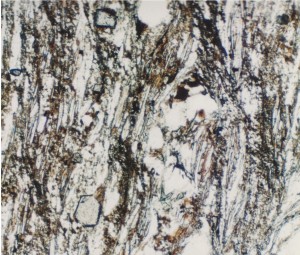 My posts on metamorphism form a sequence. I start with what anyone ought to know, the core concepts of metamorphic facies and how we estimate conditions of metamorphism. Next I cover the concepts of grade, zones, index minerals and Barrovian metamorphism. What useful things can metamorphic rocks tell us? Well Pressure-Temperature-time paths are useful things to know, and can be related to tectonic conditions such as mountain-building or subduction. What about the business of quantifying the conditions of metamorphism, thermobarometry, is it really witchcraft? Looking at complications to thermobarometry, how easy is it to achieve chemical equlibrium and is metamorphism really closed? Looking at work on the cutting edge, how can we use geospeedometry to put the t in P-T-t?
My posts on metamorphism form a sequence. I start with what anyone ought to know, the core concepts of metamorphic facies and how we estimate conditions of metamorphism. Next I cover the concepts of grade, zones, index minerals and Barrovian metamorphism. What useful things can metamorphic rocks tell us? Well Pressure-Temperature-time paths are useful things to know, and can be related to tectonic conditions such as mountain-building or subduction. What about the business of quantifying the conditions of metamorphism, thermobarometry, is it really witchcraft? Looking at complications to thermobarometry, how easy is it to achieve chemical equlibrium and is metamorphism really closed? Looking at work on the cutting edge, how can we use geospeedometry to put the t in P-T-t?
Originally these posts started out as a short note in a blog post about the Vredefort impact structure. I was talking about the amazing things metamorphic petrologists had discovered and wanted to quickly summarise how they got their results. My quick summary soon turned into a post of its own, and then split off into multiple posts.
I’ve been encouraged to write these post by an off-the-cuff remark from Dana Hunter (and her inspiring post “Adorers of the Good Science of Rock-breaking“). I learnt my metamorphic petrology 15+ years ago and I wanted to write about what is left in my memory. Not the chemical formula of staurolite, but the interesting stuff – understanding, not just knowledge. An excellent post by MK (part of the education themed Accretionary Wedge #38) gave me a name for this, the scaffolding.

Pingback: Thermobarometry: quantifying metamorphic conditions | Metageologist
Pingback: Metamorphism: Pressure-Temperature-time paths | Metageologist
Pingback: Metamorphism: grade, zones, index minerals, and whisky | Metageologist
Pingback: What you ought to know about metamorphism | Metageologist
Pingback: Metamorphism: evolving ideas | Metageologist
Pingback: Metamorphism: open or closed? | Metageologist
Pingback: Eclogites: back to the surface | Metageologist
I am regular reader, how are you everybody?
This article posted at this web page is truly nice.
Arnetta
Pingback: Metamorphic petrology: under pressure and getting stressed? | Metageologist
Metamorphic rock – Encyclopedia of Earth
What a great service you are offering to the public! As a long retired geologist and friend of metamorphic and syrupy-looking rocks everywhere I am so delighted. Really great job!
You are doing such a great public service! As a long retired geologist, and friend of metamorphic rocks everywhere, no matter how convoluted, I salute you. Well done!